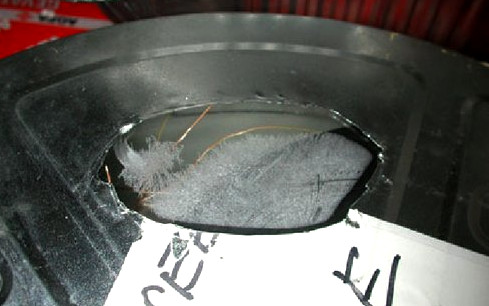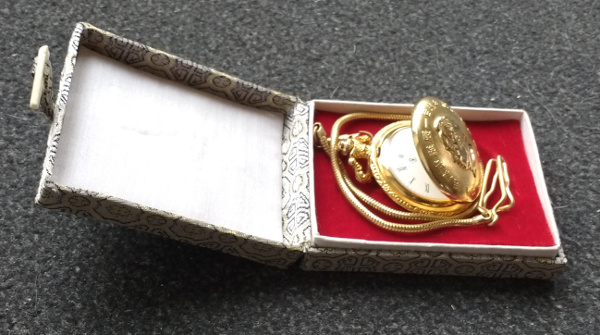
 |
Transporting a clock |
A whole book (Stolow 1987) has been written about moving artefacts. A more recent, and much shorter, document is the "Art in Transit Handbook" (Richard et al. 1997). The 'art' in the title refers only to paintings, but much of the advice can transfer directly to moving other objects.
One can ask what is the point of competing with these two well-reviewed publications. In this article, I deal with an important phenomenon which is mentioned but not explained in the handbook and which seems to be widely misunderstood, or just neglected. Here are two quotes from the Art in Transit handbook which I will expand into a tutorial about moisture movement in a package exposed to a varying temperature.
"If trucks are to be used for transportation for long periods of time and in adverse weather, use temperature-controlled trucks and relative humidity-controlled cases."
"Polyethylene increases the risk of condensation when paintings are packed in uninsulated cases. However, experiments have indicated that the risk is small when the packing case contains a minimum of 5 cm (2 in.) of thermal insulation and the painting is maintained at a level of relative humidity below 70%."
The essential characteristic of artifacts in transport is that they are usually closely enclosed. This means that the air space around them is of limited volume and exchanges slowly with the ambient air. This air space has its relative humidity firmly controlled by even a small quantity of absorbent material, in the object or in its packaging. This is because there is very little water vapour in the air space compared with the amount of exchangeable water in the object. It is the object which controls the RH in a small enclosed space.
This RH control can be explained from the absorption curves for cotton, shown in figure 1.
Figure 1. Sorption isotherms of cotton at three temperatures, traced from (Urquhart and Williams 1924).
As the temperature falls from 30°C to 10°C, the RH in equilibrium with the cotton, which is assumed to keep a very nearly constant water content, diminishes by about 7 percent points.
Deliberately added humidity buffer performs in much the same way, whether it is silica gel, paper or some commercial buffer. The steepness of the curves will vary, but the closeness of the curves for different temperatures is universal.
A humidity buffer is generally regarded as a good thing, which never misbehaves. This is naive. For the added buffer to provide stability to the object, it must be at the same temperature as the object. If there is a temperature difference, even transiently, between buffer and object, the RH around the object will be de-stabilised.
This is not obvious, so a worked example may help. Suppose the object started its journey at 30°C and in equilibrium with its usual environment at 50% RH. The truck ploughs through a snowstorm and the interior drops below 10°C, which temperature is soon acquired by the paper buffer which lines the thin-walled transport case. The paper, which also began the journey in equilibrium at 50% RH, will assert a RH about 45% in its immediately adjacent layer of air, according to the diagram above. This cold layer of air at the buffer surface will move away by convection and will not change its water content so long as it does not encounter another buffer material. It will eventually migrate close to the object, which is also cooling, but more slowly, say to 27°C at this moment. So what is the RH in the surface layer of air next to the object?
To calculate this value we need a second diagram: the psychrometric chart.
Figure 2. The psychrometric chart for sea level average atmospheric pressure (101.325 kPa). This simplified version shows the relationship between temperature, RH and the water vapour concentration expressed in kg of water per kg of dry air.
This chart describes the behaviour of moist air in an unbuffered enclosure, with no moisture-active surfaces (Padfield 2010). As the cool air moves towards the warmer object, while retaining a constant vapour concentration in grams per gram of dry air, the RH falls, reaching 15% at 27°C.
The enclosed object will therefore lose water to its immediate environment. Furthermore, if the buffer has a large capacity in comparison with the object, the dehydrating effect will be powerful.
A good basic rule for packaging is to use the minimum amount of buffer, which in many cases will be none at all, and to keep it as close in temperature to the object it is protecting. Because there is minimal buffer, the package enclosing buffer and object should be airtight to a degree depending on the time of transit. It is impractical to measure the half time to equilibrium with the ambient air composition, so for transport lasting a few hours it is usually adequate to use a polyethylene bag with enough length to allow rolling the open side and then folding it and putting a clip on, as shown in figure 3. Polyethylene bags usually have a thin surface film of an anti-sticking material to allow easy opening of the empty bag. The merit of a thin layer of buffer paper is that it separates the slick polyethylene surface from the object.
Figure 3. The sequence of operations for packing an artifact for transport. In practice the paper should fully enclose the object and there should be shock absorbing cushions in the outer case.
The plastic enclosure will ensure a reasonably close embrace of the paper buffer on the object, but there is still a need for insulation of the outer transport case. This is because a three dimensional object can suffer an internal temperature gradient sufficiently large to cause condensation within the parts of the object itself. An example is the condensation within a movie film can when it is suddenly plunged into a cold store (figure 4).

Figure 4. Condensation is visible on the inside surface of a plastic window in a film can. The can of warm film has just been put into a box at minus 18°C. Moisture is migrating from the gelatin component of the still warm roll of film to condense on the rapidly cooling can.
Here is the second rule for packaging: there should be thermal insulation outside the humidity buffer. Even if the buffer is close to the object, there can still be transient temperature differences within the artefact itself, so it is important to reduce the rate of change of temperature within the assembly.
Calculating how much insulation is needed is quite complicated, because the rate of the temperature change within an insulated box depends not only on the insulation thickness and thermal resistance but also on the heat capacity of the enclosed object. An empty box will cool quickly, in spite of thick insulation, because the heat capacity of the enclosed air is very small. The insulation should be thicker, the lighter the object.
It is correct, but still not very helpful, to specify that there should never be more than an eight degree temperature difference between any two points within the insulated enclosure, to avoid the risk of condensation anywhere within the package. This is because the dew point of air in equilibrium with an object equilibrated to 50% RH will generally be about 10°C below its surface temperature. This generalisation is valid over a large temperature range (Padfield 2002).
Figure 5. This simple experiment gives an idea of what is needed in the way of thermal protection for an object of considerable thermal mass. A set of four polyethylene water containers was piled up within an insulating bag. The containers held 3 litres of water, evenly distributed, with an approximately 10 mm air space over the water surface in each container. The approximate dimensions of the pile of water containers were 180 x 110 x 250 mm high. The bag fitted loosely around this pile. The bag consisted of two layers of plastic covered fabric enclosing 3 mm of very open polyurethane foam. Thermocouples were set underneath the pile, between each container and over the top container.
This arrangement, though primitive, just fulfils the 8°C criterion for resistance to condensation. This is quite a challenging example, because water has a high heat capacity, and it mixes by convection as it cools, thus maintaining a nearly uniform temperature through the pile of containers. The main temperature difference is between the water containers and the walls of the enclosing bag. This is less than eight degrees during the cooling period, except for the initial heating of the bag, which would not happen in a real transport event.
What emerges from this analysis is that climate control around an artefact in transit is quite simple and does not require exotic and expensive materials and constructions.
The box must not be opened until it has come close to temperature equilibrium with its new surroundings. The delay will depend on the thermal resistance of the insulation and the heat capacity of the contents. In the case of regular shipments, of a pallet of books for example, it is worth embedding a data logger for a pilot journey, to optimise the insulation thickness and the delay after delivery. For unique items, one just has to be patient. A more nerdish solution is to build a thermocouple into the case, with a dangling connector taped to the outside of the case. This can be plugged into a hand held measuring unit in the reception area. Thermocouple wire (extension grade) is cheap and robust. I recommend type K, which is springy and can be mounted to touch lightly against the inner container.
Radiant energy from sulight on a box left out in the sun penetrates according to different rules from thermal conduction. A shiny metallic surface will reflect most of the radiation. Shading with a drape over the box is not as effective as one might think. The short wavelength sunlight and infra red radiation is absorbed and re-radiated to the box below at a longer wavelength, whose penetration through materials is different. The detail is complicated but the solution is simple: reflect the radiation with shiny metal, which can be aluminised plastic, or white paint.
Aircraft cabins and baggage holds are depressurised during flight, this will swell the nearly sealed polyethylene bag, so it should have spare volume to allow this. The fall in pressure reduces the RH proportionately to the pressure change, even at constant temperature. This is because the water vapour concentration, expressed as g/m3, reduces but the saturation concentration in the space does not, so the RH falls. During the flight the buffer will restore the RH so that when the aircraft re-pressurises on its descent, the RH will briefly rise above the starting equilibrium. It is impractical to make a case resistant to atmospheric pressure change, but no harm has been reported to artifacts, even in the past when aircraft were not pressurised at all.
Protection against vibration and shock is thoroughly treated in the Art in Transit handbook. Here I will only remark that the thermal insulation should be continuous around the inside of the case and will therefore usually be too stiff to deform if the object bounces against it. Soft materials to absorb bangs from accelerated artefacts must be disposed specifically to prevent damage by movement. These materials often are foam insulators, but that is not relevant when they are discontinuously arranged to give a resilience matched to the density and shape of the object. For an institution which regularly ferries stuff between store and distant study rooms the vibration calming is best built into the truck rather than the individual packages.
I have used paper as a buffer in this explanatory article. It is also a good buffer in the real world. There are much more expensive materials such as silica gel, which is abrasive and prone to powder, and Art Sorb, which contains encapsulated lithium chloride, which escapes in a flood, and can only be removed from objects by thorough washing. These materials have better buffer capacity per unit volume, but this advantage is seldom needed. It is better to concentrate on reducing air leakage rather than fight the incoming air with abundant humidity buffer.
Should the clock be wound before transport, or allowed to run down? My recommendation follows the image below.

Figure 6. Chairman Mao Memorial fob watch, in well buffered original container.
Answer: the clock should be run down so the coils of the spring are separated and more quickly come to thermal equilibrium than the tightly wound metal cylinder of the fully wound clock. Also, a muffled tick-tock from a box in a vehicle might arouse suspicion in security people.
Nathan Stolow, 1987, Conservation and Exhibitions: Packing, Transport, Storage, and Environmental Considerations. Butterworth-Heinemann. 288 pages. ISBN-10: 0408014342, ISBN-13: 978-0408014342.
Mervin Richard, Marion Mecklenburg and Ross Merrill, 1997. Art in Transit Handbook, National Gallery of Art, Washington DC, 1997, ISBN 0-89468-165-6.
https://repository.si.edu/bitstream/handle/10088/8127/mci_Art_in_Transit_Handbook_for_Packing_and_Transporting_Paintings.pdf?sequence=1&
Urquhart, A.R. and Williams, A.M. 1924 'Absorption isotherm of cotton', J.Textile Inst. 1924 pp 559-572.
Tim Padfield, 2010. The psychrometric chart explained: www.conservationphysics.org/mollier/moll1.html
Tim Padfield, 2002. 'Condensation in film containers during cooling and warming', Proceedings of the conference 'Preserve, then Show', The Danish Film Institute, Copenhagen, December 2001, published September 2002.
www.conservationphysics.org/coolfilm/coolingfilm.pdf

This work is licensed under a Creative Commons Attribution-Noncommercial-No Derivative Works 3.0 License.